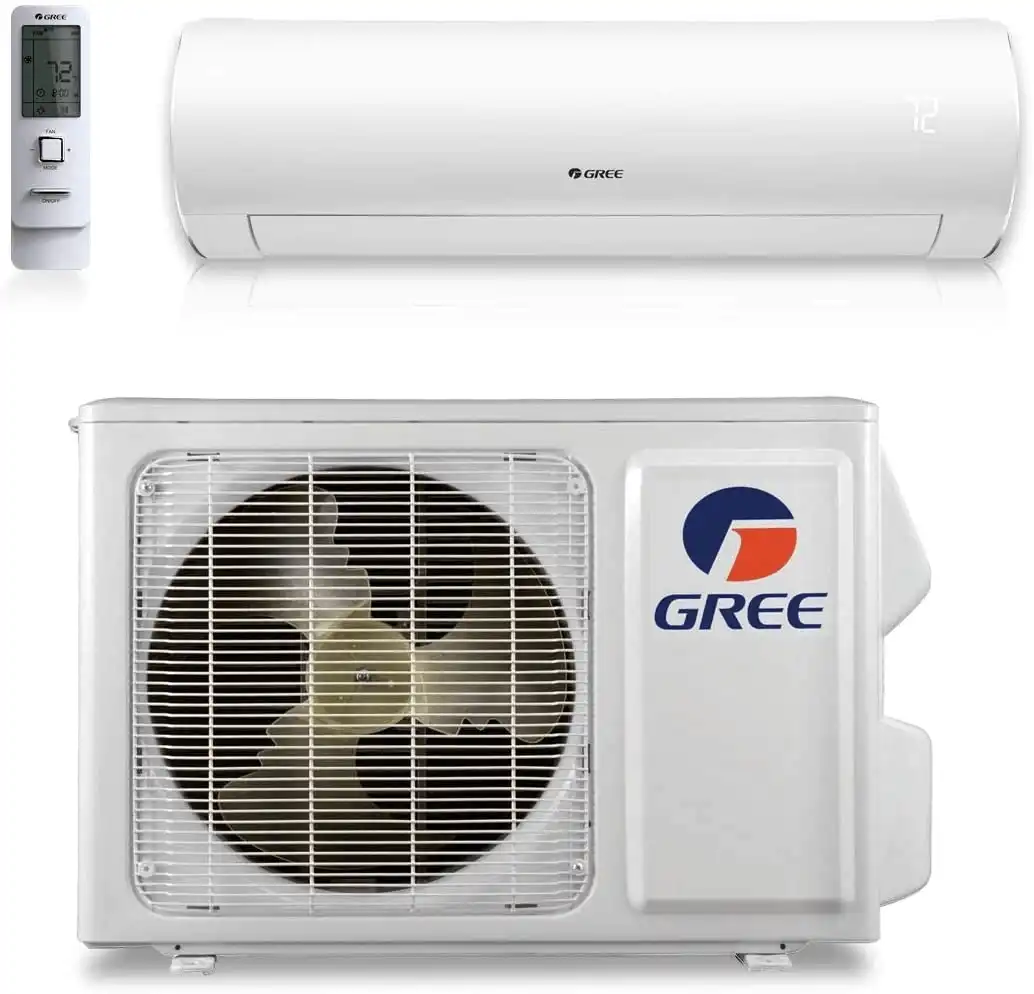
Ultimate Guide to Eco-Friendly Mini-Split Systems
Ultimate Guide to Eco-Friendly Mini-Split Systems
For HVAC contractors looking to stay ahead in the growing demand for energy-efficient solutions, eco-friendly mini-split systems offer an exceptional opportunity. These systems not only help reduce energy costs but also align with evolving efficiency standards and customer expectations. With features like zoned temperature control, advanced refrigerants, and smart technology, mini-splits are quickly becoming a preferred choice for both residential and commercial applications.
Failing to understand the benefits and proper installation of GREE's eco-friendly mini-splits can lead to missed opportunities. In this guide, we'll cover everything you need to know - from key features and system selection tips to installation best practices and maintenance strategies. By the end, you'll have the tools to confidently recommend and install eco-friendly mini-split systems, ensuring long-term customer satisfaction and business growth.
Get started designing efficient systems with GREE's System Builder tool.
Key Features of Eco-Friendly Mini-Split Systems
When it comes to eco-friendly mini-split systems, understanding what sets them apart can help contractors recommend the right options and clearly communicate their benefits. These systems combine cutting-edge technology to reduce environmental impact while maintaining optimal comfort. Let's explore the standout features that make these systems a smart choice.
Energy Efficiency and SEER Ratings
The Seasonal Energy Efficiency Ratio (SEER) is a key measure of how efficiently a cooling system operates over a season. A higher SEER rating means the system uses less energy, which translates to lower utility bills. While standard mini-splits typically have SEER ratings between 16 and 20, eco-friendly models like GREE SAPPHIRE and VIREO+ achieve up to 28.5 SEER2 and 18 HSPF2, exceeding 2023 DOE efficiency standards.
One reason for this efficiency is the use of inverter-driven compressors, which adjust their output based on demand. Instead of constantly cycling on and off, these compressors operate at low capacity when full power isn't needed, maintaining consistent temperatures and minimizing energy waste. Additionally, modern systems are equipped with enhanced heat pump performance, allowing them to heat efficiently even in temperatures below 0°F. This ensures reliable performance in conditions where older systems might falter.
Low-Impact Refrigerants
The type of refrigerant used plays a big role in a system's environmental impact. Many eco-friendly mini-splits now use refrigerants with a lower Global Warming Potential (GWP), which helps reduce their contribution to climate change.
A popular choice is R-32 refrigerant (GWP 675), which offers ~68 % lower impact than R-410A and complies with the EPA AIM Act 2025 refrigerant transition. Installers must follow IMC 1107 and manufacturer safety protocols for A2L refrigerants. Beyond its environmental advantages, R-32 also offers better thermodynamic properties, helping systems achieve higher energy efficiency with less refrigerant. This can lead to lower installation costs and make servicing easier.
Next-generation refrigerants like R-454B are also entering the market, boasting GWP values under 500. However, these require new safety and installation protocols to ensure proper handling.
Smart Controls and Automation
Smart technology has revolutionized how mini-split systems manage energy, making them smarter and more efficient. WiFi-enabled controls allow systems to learn user habits and adjust settings to avoid wasting energy when spaces are unoccupied.
Features like programmable scheduling let users customize temperature settings for different times of day, weekdays, weekends, or even seasons. Some systems go a step further by integrating occupancy sensors and geofencing technology, which adjust temperatures automatically based on whether someone is present or approaching the home.
In multi-zone setups, smart multi-zone coordination ensures that energy is distributed where it's needed most, rather than running all zones independently. This dynamic balancing can significantly improve overall efficiency.
Advanced systems also integrate with home automation platforms and participate in utility demand response programs, which adjust system operations during peak electricity pricing periods. Plus, the data collected by these smart controls supports predictive maintenance, helping contractors spot potential issues before they escalate into major problems.
GREE Comfort leads the way with smart Wi-Fi control, occupancy sensors, and geofencing built into systems like the MULTI21+ series, ensuring peak energy-efficient performance and convenience.
System Selection Guide for HVAC Contractors
When choosing a mini-split system, it's important to balance performance, efficiency, and cost while prioritizing eco-friendly options. The goal is to select a system that fits the project's needs, saves energy, and keeps clients happy.
Matching System Capacity to Space Requirements
Getting the system size right is critical. A system that's too large wastes energy, while one that's too small will struggle to keep up, leading to higher wear and tear.
Start with a Manual J load calculation to figure out the heating and cooling demands. This calculation considers factors like square footage, ceiling height, insulation quality, window placement, and the local climate. On average, a space needs 20–25 BTU per square foot, per IMC 2021 §312 and ACCA Manual J.
For example:
- A 500-ft² room typically requires 9,000–12,000 BTU.
- A 1,000-ft² space might need 18,000–24,000 BTU.
- Adjustments may be necessary for spaces with large south-facing windows or poor insulation.
Zoning is another factor to consider. For multi-zone systems, calculate the capacity for each indoor unit based on the specific needs of its room, rather than dividing the total load evenly. Climate also matters - if you're working in colder regions, choose a system that maintains its full heating capacity even in low outdoor temperatures.
Once the capacity is clear, it's time to choose the system configuration.
Single-Zone vs. Multi-Zone Systems
After determining capacity, decide whether a single-zone or multi-zone system is the better fit. This choice depends on the application, budget, and client preferences.
Single-zone systems are ideal for individual rooms, home additions, or areas with similar usage patterns. They're easier to install and maintain, and if one unit fails, the others remain operational. This makes them a great option for spaces like rental properties, home offices, or specific zones needing extra cooling or heating.
Multi-zone systems, on the other hand, connect multiple indoor units to a single outdoor unit, making them perfect for whole-home or multi-room applications. While they cost more upfront, they can be more cost-effective than installing several single-zone systems. Multi-zone setups also save space outside the building since they only require one outdoor unit.
When deciding, think about:
- Budget: Single-zone systems have lower upfront costs but may add up if multiple units are needed. Multi-zone systems require a larger initial investment but can be more economical for larger projects.
- Installation complexity: Single-zone systems are simpler to install. Multi-zone systems involve more intricate setup and coordination.
- Flexibility: Single-zone systems allow for independent control of each space, which is helpful if usage patterns vary widely.
GREE Comfort offers both single-zone and multi-zone configurations, including the MULTI21+ platform with capacities up to 60,000 BTU for large projects. Use the System Builder tool to design the optimal setup.
Installation Best Practices
Proper installation is crucial for ensuring that eco-friendly mini-split systems operate at peak efficiency and deliver long-term reliability. Poor installation can reduce system performance, increase energy costs, and even void warranties. Here are the key best practices contractors should follow.
Pre-Installation Planning
Before starting an installation, it's essential to plan carefully. Verify that the selected system matches the calculated load requirements per ACCA Manual S guidelines. This ensures the system is neither oversized nor undersized, both of which can lead to inefficiencies.
Inspect the installation site to confirm proper clearances around the outdoor unit per manufacturer specifications and IMC §304. Check for structural support requirements and ensure that wall-mounted indoor units are securely fastened to studs or appropriate backing. Proper planning also includes verifying electrical requirements and ensuring adequate power supply, as well as confirming that the location allows for proper drainage of condensate.
Outdoor Unit Placement
The placement of the outdoor unit significantly impacts system performance. Install the outdoor unit on a level, stable surface using vibration-dampening pads per ASHRAE guidelines to reduce noise and prevent structural damage. Position it away from direct sunlight, heavy snow accumulation, and areas prone to debris buildup to maintain optimal airflow.
Ensure adequate clearance around all sides of the unit - typically 20 inches on the service side and 12 inches on other sides - to allow for proper airflow and serviceability per manufacturer specifications. Avoid placing the unit in enclosed spaces or areas with restricted ventilation, as this can cause the system to overheat and reduce efficiency.
Refrigerant Line Installation
Refrigerant line installation is one of the most critical steps. Use properly sized copper tubing as specified by the manufacturer and ensure all connections are clean, burr-free, and properly flared or brazed per ASME B31.5 standards. Avoid kinks, sharp bends, or restrictions in the refrigerant lines, as these can impair system performance.
Insulate refrigerant lines completely to prevent energy loss and condensation. Secure the lines properly to prevent vibration and wear. After installation, perform a thorough pressure test and vacuum evacuation before charging the system with refrigerant. Any moisture or air left in the lines can damage the compressor and reduce efficiency.
Electrical Connections and Safety
Proper electrical installation is essential for both safety and performance. All electrical work must comply with NEC Article 440 and local codes, using appropriately sized wire and overcurrent protection per manufacturer specifications. Install a dedicated disconnect switch within sight of the outdoor unit for safety and code compliance per NEC 440.14.
Verify voltage and amperage at the installation site to ensure compatibility with the system requirements. Use weatherproof junction boxes and properly seal all outdoor connections to prevent moisture intrusion. Double-check all wiring before energizing the system to avoid damage to components.
Condensate Drainage
Proper condensate drainage prevents water damage and mold growth while maintaining system efficiency. Install the indoor unit with a slight pitch toward the drain outlet per IPC §314 to ensure gravity drainage. Use appropriately sized drain lines and avoid traps that could restrict flow unless specifically required by the manufacturer.
If a condensate pump is needed, ensure it is properly sized and installed with appropriate safety switches per manufacturer requirements. Test the drainage system thoroughly after installation to confirm proper flow and check for leaks.
System Commissioning
After installation, proper commissioning ensures the system operates as intended. Verify refrigerant charge using manufacturer-specified methods - this may include superheat, subcooling, or weighing in the charge per EPA Section 608 requirements. Improper charge is one of the most common installation errors and can significantly reduce efficiency.
Test all system functions, including heating, cooling, fan speeds, and any smart controls or automation features. Verify that airflow from indoor units is adequate and evenly distributed. Check for unusual noises, vibrations, or odors that could indicate installation problems.
Document all installation parameters, including refrigerant pressures, temperatures, and electrical readings per GREE Comfort warranty requirements. Provide the client with operation and maintenance instructions, and demonstrate system controls.
Contractors can access detailed installation guidance through GREE's Instructional Videos and the FAQ section.
Maintenance and Longevity
Regular maintenance is essential to keep eco-friendly mini-split systems running efficiently throughout their lifespan. Without proper care, these systems can lose efficiency over time, reducing both their environmental and cost-saving benefits. Here are some key maintenance practices to ensure your system stays in top shape.
Routine Maintenance Tasks
A solid maintenance plan should include regular cleaning and professional inspections. GREE Comfort recommends annual service (bi-annual in heavy-use regions). However, for systems that handle both heating and cooling, scheduling maintenance twice a year - preferably in spring and fall - is often recommended. See maintenance guidance in the GREE FAQ.
Each service session should start with a check of the system's operation and safety. A visual inspection of both the indoor and outdoor units can help identify wear, damage, or blockages. Cleaning should focus on filters, coils, blower wheels, and outdoor components, as these directly impact energy efficiency.
Filters are particularly important - follow the manufacturer's recommendations for cleaning or replacing them. Clogged filters make the system work harder, reducing its efficiency and increasing energy use.
Professional tune-ups take maintenance to the next level. These include cleaning, checking refrigerant levels, inspecting electrical connections, lubricating moving parts, and ensuring the system operates at peak efficiency. Technicians often measure key performance metrics during these visits, helping to catch potential issues early and extend the system's lifespan.
Extending System Lifespan
Preventive maintenance does more than just keep the system running - it helps sustain energy efficiency and reduces the likelihood of costly repairs. Regular maintenance plans ensure you never forget annual tune-ups and often include benefits like priority service and discounts on repairs. More importantly, they catch small problems before they become major, expensive failures, easily paying for themselves in energy savings and extended equipment life.
Regular checks of electrical connections and other critical components are particularly important for preventing inefficiencies and ensuring safety.
Tracking Maintenance Schedules
To preserve efficiency and performance, it's vital to stay on top of maintenance schedules. Combining routine tasks with professional tune-ups and a structured schedule ensures the system continues to perform well over the long term. Many HVAC professionals recommend maintenance plans to help clients stick to these schedules. Such plans often include perks like priority service and repair discounts, making them a smart investment.
For added convenience, consider using digital smart controls to automate maintenance reminders. GREE Comfort's smart control systems, for instance, integrate with contractor management software, making it easier to schedule service and track system performance.
Contractors can track maintenance schedules through GREE smart controls and training resources.
Key Takeaways for Contractors
As the HVAC industry shifts toward greener technologies, eco-friendly mini-split systems present a valuable opportunity for contractors to stand out while addressing the increasing demand for energy-efficient heating and cooling solutions. This guide provides a thorough approach - from selecting the right system to ensuring ongoing maintenance - giving contractors the tools they need to thrive in this evolving market. By integrating these strategies, contractors can deliver high-efficiency results. Explore GREE's System Builder, Instructional Videos, and FAQ for support.
Eco-Friendly Mini-Splits: Advantages for Contractors and Clients
GREE's eco-friendly mini-split systems, such as the VIREO+ and SAPPHIRE series, bring significant benefits to both contractors and their clients. With efficient installation practices and consistent maintenance, these systems often lead to higher customer satisfaction and stronger word-of-mouth referrals. Features like advanced efficiency, environmentally friendly refrigerants, and smart controls ensure reliable performance that clients can count on.
For contractors, these systems offer a competitive advantage. The versatility of single-zone and multi-zone configurations allows for tailored solutions, whether for retrofitting older properties or outfitting new constructions. Additionally, energy incentives can serve as a valuable selling point, helping contractors close deals while boosting project profitability.
Maintenance for these systems is straightforward but essential, creating opportunities for contractors to establish ongoing service agreements. Tasks like regular filter cleaning, annual tune-ups, and performance checks help maintain system efficiency over time. This predictable maintenance schedule not only protects the client's investment but also provides contractors with a steady revenue stream.
Steps Toward Adopting Eco-Friendly HVAC Solutions
To fully leverage the benefits of eco-friendly mini-split systems, contractors need both technical expertise and access to reliable products. GREE Comfort's product range offers the tools needed to meet a variety of client needs effectively.
For a streamlined system selection process, contractors can use GREE Comfort's System Builder tool. This resource helps ensure accurate system sizing and identifies the best configurations for specific applications, making it easier to deliver optimal solutions.
Staying informed about industry developments and product advancements is crucial for maintaining a competitive edge. By combining technical knowledge, high-quality products, and a structured maintenance approach, contractors can meet the growing demand for sustainable HVAC solutions. This not only strengthens client relationships but also reinforces a commitment to performance and environmental responsibility.
What are the key advantages of eco-friendly mini-split systems compared to traditional HVAC systems?
Eco-friendly mini-split systems bring a range of benefits compared to traditional HVAC setups. One standout feature is their energy efficiency, with cooling ratings reaching up to 28.5 SEER2 and heating ratings of 18 HSPF2. These impressive figures translate into lower energy consumption, which can help trim down utility bills while reducing overall energy use. By using R-32 refrigerant and inverter technology, GREE systems cut emissions and power consumption compared to traditional HVAC units.
Another key advantage is their zoning capability. Mini-split systems let you heat or cool specific rooms or areas, rather than the entire building. This targeted method reduces energy waste and provides better comfort where it's needed most. On top of that, their smaller carbon footprint and easier installation - thanks to the lack of extensive ductwork - make them a practical and environmentally conscious choice for many homeowners and businesses.
How can I choose the right size and type of mini-split system for my space and climate?
Calculating the right size and type of mini-split system begins with determining the square footage of the area you want to heat or cool. Use 20 BTU/ft² as a preliminary value but perform an ACCA Manual J calculation to comply with IMC §312 and ensure correct sizing. However, other key factors - such as the quality of insulation, the amount of sunlight the space receives, and the height of the ceilings - can influence the BTU requirements. For example, a 12,000 BTU unit typically works well for areas ranging from 400 to 600 square feet, but spaces with significant heat gain may need a unit with greater capacity.
For the most precise sizing and setup, it's a good idea to consult a professional HVAC technician. They can perform a detailed load calculation, which considers your climate, the building's unique features, and energy efficiency goals. This approach not only ensures maximum comfort but also helps reduce unnecessary energy use.
How can I maintain an eco-friendly mini-split system to keep it energy-efficient?
To ensure your eco-friendly mini-split system operates at its best, routine maintenance is key. Clean or replace filters every 4–6 weeks per GREE Comfort maintenance guidelines to maintain airflow and efficiency. This helps maintain proper airflow and prevents unnecessary strain on the system. It's also a good idea to inspect the outdoor unit every few months, removing any debris and cleaning the coil to support efficient heat exchange.
Don't overlook the importance of scheduling professional servicing once a year. A technician can check refrigerant levels, verify that all components are working properly, and catch potential problems before they escalate. By following these straightforward steps, you can boost energy efficiency and keep your system running smoothly for years to come.




